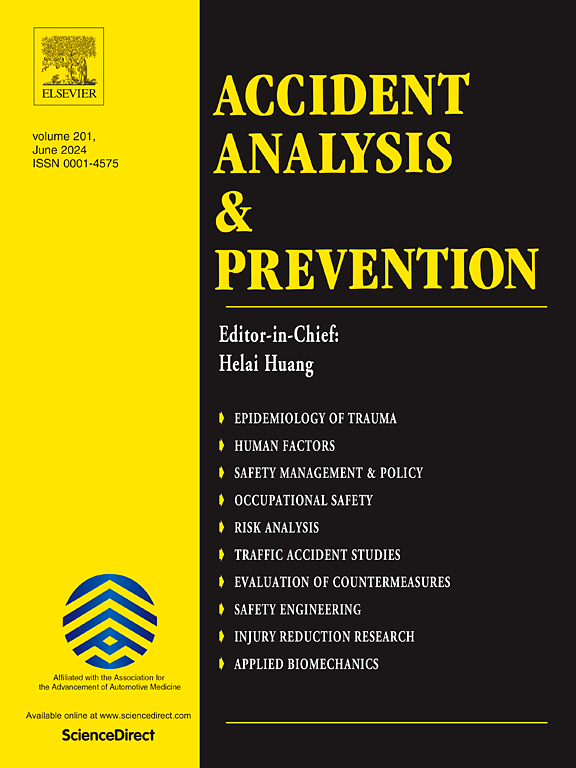Impact of anger-inducing situations on driver takeover behavior in highly automated vehicles
IF 5.7
1区 工程技术
Q1 ERGONOMICS
引用次数: 0
Abstract
Motor vehicle accidents, often caused by human error, remain a significant concern. While automated vehicles have the potential to reduce these accidents by handling driving tasks, unnecessary human takeovers, especially when the automated system is operational, can reintroduce error. This study investigates how situational factors known to trigger anger influence takeover behavior and emotional responses in levels 4 and 5 automated vehicles. Using a driving simulator, 60 participants were randomly assigned to either a goal-aligned condition (clear weather, on-time departure, no traffic) or a goal-conflicting condition (dense fog, delayed departure, slow vehicles). Participants could freely choose between manual and automated driving modes. Results showed a significant increase in takeover frequency, higher negative affect and anger in the goal-conflicting condition compared to the goal-aligned condition. Qualitative data gathered from open-ended questions revealed increased stress and frustration leading to more frequent manual takeovers in goal-conflicting conditions, while participants felt calmer with fewer takeovers in goal-aligned conditions. No link was found between takeover behavior and trust in driving automation. These findings highlight the importance of designing Automated Driving Systems (ADS) that minimize stressors and consider drivers’ emotional states to enhance safety and comfort. In this regard, incorporating real-time emotional monitoring and employing cognitive behavioral therapy (CBT) strategies (e.g., situation reappraisal) may help mitigate driver emotional states and prevent unnecessary takeovers.
高度自动化车辆中引发愤怒的情境对驾驶员接管行为的影响
机动车辆事故往往是由人为失误引起的,这仍然是一个重大问题。虽然自动驾驶汽车有可能通过处理驾驶任务来减少这些事故,但不必要的人为接管,尤其是在自动系统运行时,可能会重新引入错误。本研究探讨了在4级和5级自动驾驶汽车中,引发愤怒的情境因素如何影响接管行为和情绪反应。使用驾驶模拟器,60名参与者被随机分配到目标一致的条件下(天气晴朗,准时出发,没有交通)或目标冲突的条件下(浓雾,延迟出发,缓慢车辆)。参与者可以自由选择手动和自动驾驶模式。结果显示,与目标一致组相比,目标冲突组的接管频率显著增加,消极情绪和愤怒情绪显著增加。从开放式问题中收集的定性数据显示,在目标冲突的情况下,压力和挫败感的增加导致更频繁的手动接管,而在目标一致的情况下,接管次数减少,参与者感到更平静。没有发现接管行为和信任在推动自动化方面的联系。这些发现强调了设计自动驾驶系统(ADS)的重要性,该系统可以最大限度地减少压力源,并考虑驾驶员的情绪状态,以提高安全性和舒适性。在这方面,结合实时情绪监测和采用认知行为疗法(CBT)策略(例如,情况重新评估)可能有助于减轻司机的情绪状态,防止不必要的接管。
本文章由计算机程序翻译,如有差异,请以英文原文为准。
求助全文
约1分钟内获得全文
求助全文
来源期刊

Accident; analysis and prevention
Multiple-
CiteScore
11.90
自引率
16.90%
发文量
264
审稿时长
48 days
期刊介绍:
Accident Analysis & Prevention provides wide coverage of the general areas relating to accidental injury and damage, including the pre-injury and immediate post-injury phases. Published papers deal with medical, legal, economic, educational, behavioral, theoretical or empirical aspects of transportation accidents, as well as with accidents at other sites. Selected topics within the scope of the Journal may include: studies of human, environmental and vehicular factors influencing the occurrence, type and severity of accidents and injury; the design, implementation and evaluation of countermeasures; biomechanics of impact and human tolerance limits to injury; modelling and statistical analysis of accident data; policy, planning and decision-making in safety.
 求助内容:
求助内容: 应助结果提醒方式:
应助结果提醒方式:


